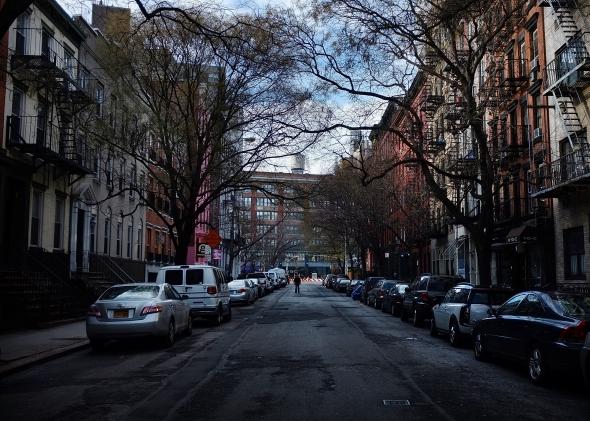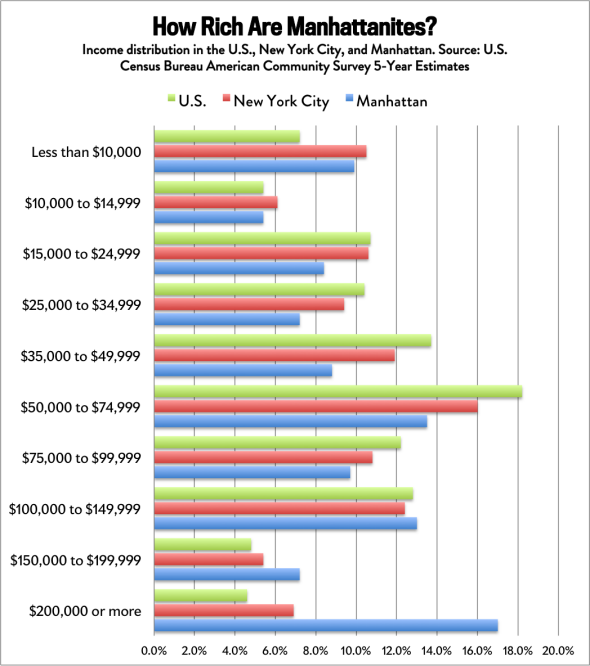Is Living in an Expensive City a “Consumption Choice,” Just Like Buying a Fancy Car?

Photo by Spencer Platt/Getty Images
Let’s talk a little more about what it means to be “rich” in New York City.
In most of the country, a family with a low six-figure income—say $150,000 or $250,000 a year—would be considered pretty affluent. But in New York, some would say that’s just middle class, since life in the city can be pricey.
Last week, I argued otherwise. First, while New York real estate is expensive, the city’s low-cost public transportation system makes it more affordable than it’s given credit for. (Most households get away without driving any cars, much less two.) Meanwhile, according to the Census Bureau, New York’s income distribution is surprisingly similar to that of the United States writ large. For instance, in the U.S., about 22 percent of households earn at least $100,000 in a year. Across the five boroughs, it’s 25 percent; nationwide, just 4.6 percent of households earn at least $200,000, while in NYC, 6.9 percent hit that mark. New Yorkers enjoy somewhat larger paychecks than other Americans. But Wall Street’s riches aside, they’re not living in another financial universe.
After my post about New Yorkers’ financial means, I got some pushback from readers who thought I was ignoring the obvious: When well-paid, white-collar New Yorkers complain about being too poor for the city, they actually mean they’re too poor for ultra-wealthy Manhattan—where 17 percent of households earn more than $200,000 a year—and the fancier parts of Brooklyn. As my podcast buddy Felix Salmon put it in a couple of tweets, “When New Yorkers talk about NYC, they mean ‘the places where people like me live and work.’ So when you tell New Yorkers they’re wrong about NYC being expensive, you’re misunderstanding what they’re saying.”

In other words, we’re talking about a problem that has to do with social class as much as New York’s income curve. Creative types and other educated professionals in New York who don’t rake in million-dollar bonuses want to live in the same nice neighborhoods as their wealthier friends, send their kids to similar schools, and eat at the same awesome restaurants they see reviewed in New York magazine. That world revolves around a small section of the city, and living in it takes more of their income.
But here’s another way of framing that problem: There are wealthy people in New York who still want to live beyond their means. Some writers, like Megan McArdle, like to argue that living in an expensive city like New York is a “consumption choice”—just like buying a fancy car or adding a pool into your backyard. I think that’s a bit unfair: People are drawn to cities that offer career opportunities and are tied to them by personal relationships that they can’t just pick up and move if they want a cheaper home.
That said, choosing an especially expensive neighborhood in the city you call home is mostly a consumption decision. You might think that living within walking distance of a pretty park or a yoga studio is essential to your mental health, but in the end those are amenities, and enjoying them, along with all the other benefits of living in New York City, is a luxury. Children do complicate the equation because of school districts. But in the end, it’s possible to raise a happy, healthy family in the lesser-known corners of Brooklyn or in a slightly suburban-seeming block of Queens. If that seems like an untenable choice to you, it says more about your sense of class than the constraints of a $100,000 or $200,000 income.
* * *
For the extra curious, I've charted out the income distributions of each of the five boroughs below. Note that, even after years of gentrification, Brooklyn still looks an awful lot like the rest of the country.
